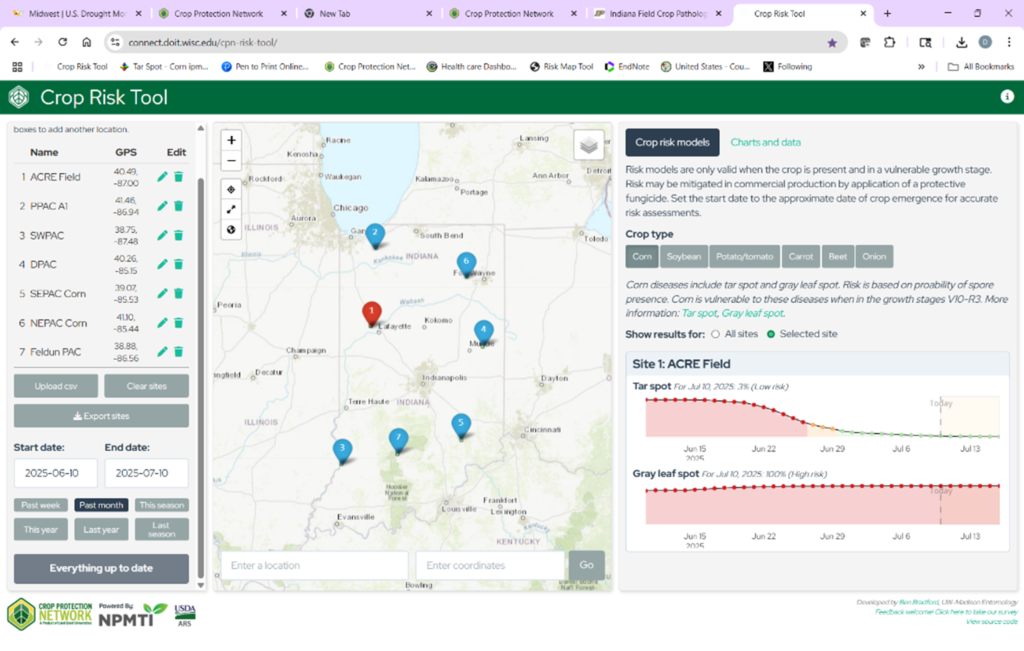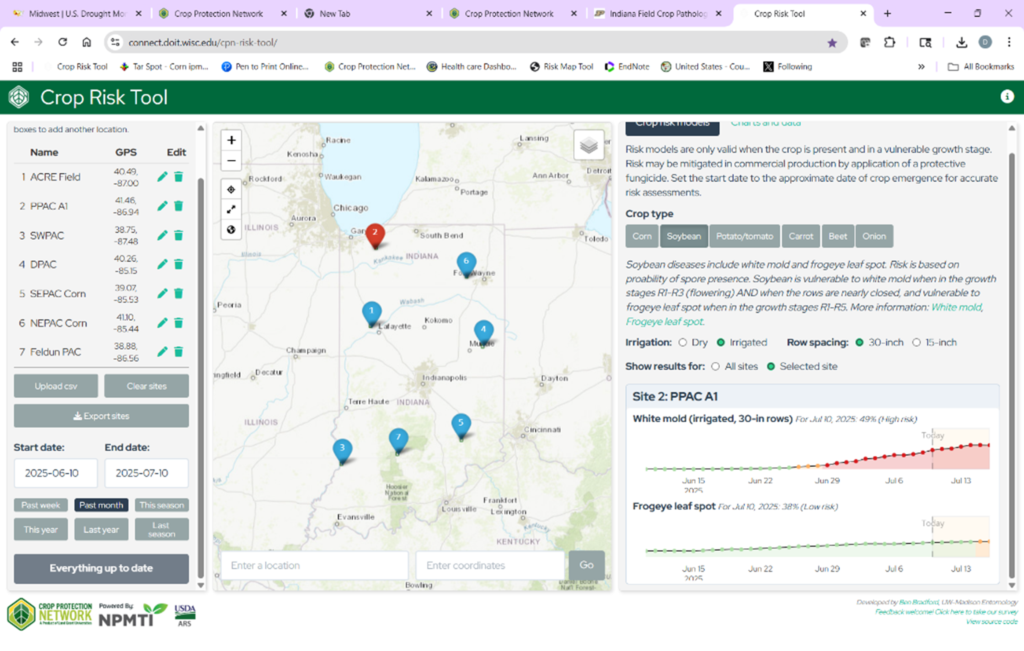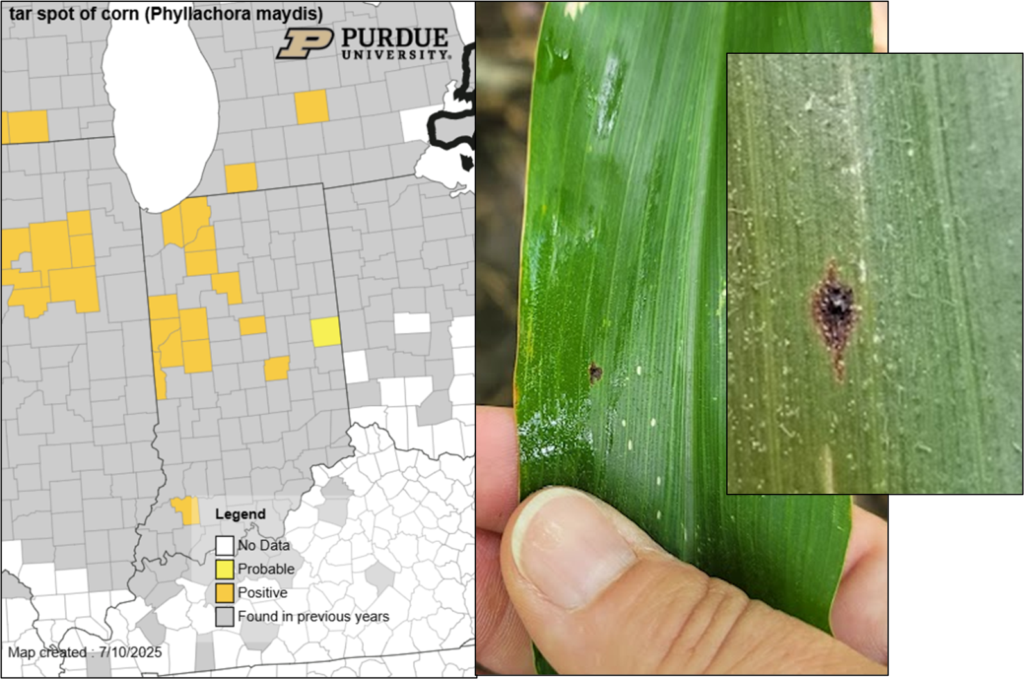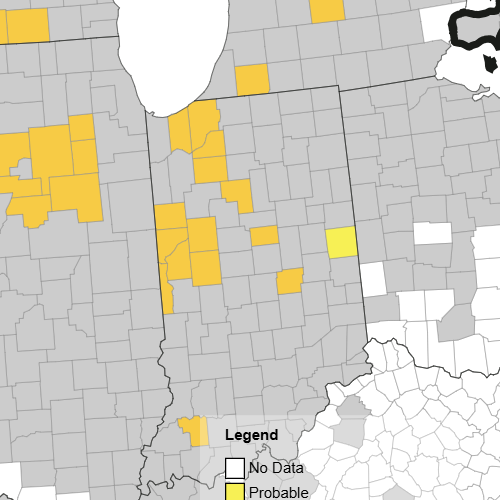It is important to continue to scout for diseases in both corn and soybeans to make informed management decisions. There is quite a range of conditions across the state with areas that have received rain and the crops look great to areas in northwest Indiana that have abnormally dry to moderately drought conditions (Midwest Drought Monitor ). In my scouting rounds and samples submitted to the Purdue Plant Pest Diagnostic Lab (PPDL) this week we continue to find tar spot (very low levels), gray leaf spot, Holcus spot, and common rust in corn. I have seen a little bit of Septoria brown spot on some lower leaves in soybean, but in general soybeans still quite clean in our fields. We continue to add counties with active tar spot in Indiana. The most frequent question I have received is, “Should we make a fungicide application?” My response – What diseases are you finding in your field? What is your hybrid/variety susceptibility, growth stages and field history? Are you irrigating?
A fungicide application can be effective at reducing disease and protecting yield, but there are a number of factors that need to be considered:
- Field history/previous crop – what diseases have been an issue in previous years?
- Amount of disease present in the field – what diseases are you finding? Where are they in the canopy? Is the disease active in your county or surrounding counties? What growth stage is the crop?
- Hybrid/variety susceptibility to diseases
- Current weather conditions and disease risk models on Crop Protection Network (https://cropprotectionnetwork.org/crop-disease-forecasting). This website now hosts all the models (tar spot (Fig 1), white mold (Sporecaster) (Fig 2), frogeye leaf spot, and gray leaf spot), so it’s a one stop shop. I suggest book marking it on your favorite device and you can return to track the disease risks on your farm.
- The value of the crop and cost of fungicide application. Guest what we have a few tools to help with these as well. Fungicide efficacy tool (https://cropprotectionnetwork.org/fungicide-efficacy-tool ) – will search all the fungicide efficacy tables based on crop and disease of concern. Corn Fungicide ROI Calculator (https://cropprotectionnetwork.org/fungicide-efficacy-tool ) – calculate the potential return on investment (ROI) for corn fungicide application based on university uniform corn fungicide trials conducted in the United States and Canada.


Tar Spot: Tar spot continues to be on everyone’s mind. We continue to add new counties where active tar spot lesions have been found in Indiana (Figure 3). We have confirmed active tar spot in 14 counties thus far this year. Tar spot had previously been found in all 92 Indiana counties. Many of these tar spot detections have required intensive scouting, but as the disease progresses it will be easier to find as the number of spots increase and it moves up the canopy. We will continue to monitor and update as the season continues.
See our publication on details for fungicide timing and applications for tar spot:
Multi-state Fungicide Efficacy Trials to Manage Tar Spot and Improve Economic Returns in Corn in the United States and Canada https://doi.org/10.31274/cpn-20240904-0.
We continue to research best management practices for tar spot to minimize losses. The good news is that we found a number of fungicides are highly efficacious against tar spot when applied from tassel (VT) to milk (R3). I would recommend picking a product with multiple modes of action. The national Corn Disease Working Group has developed a very useful fungicide efficacy table for corn diseases (see links above). We will continue keeping a close eye on tar spot. Please contact me if you suspect a field has tar spot please or send a sample to the Purdue PPDL for confirmation.

Southern Rust has not been officially confirmed in Indiana yet, but there is now one report in Missouri (Figure 4). I suspect southern rust may be found in southern Indiana where spores settled after moving on weather systems from the south. We need your help – if you are out scouting please let us know if you find any suspect samples and send to the Purdue Plant Pest Diagnostic Lab. We need a physical sample in order to confirm southern rust. https://ag.purdue.edu/btny/ppdl/Pages/Submit-A-Sample.aspx
Figure 4. Distribution of southern rust in U.S. on July 11, 2024, orange counties are positive and yellow counties are probable (https://corn.ipmpipe.org/southerncornrust/) and an example of southern rust pustules on a corn leaf and diagnostic spores. Photo credits: Darcy Telenko and John Bonkowski.
Southern rust pustules generally tend to occur on the upper surface of the leaf, and produce chlorotic symptoms on the underside of the leaf. These pustules rupture the leaf surface and are orange to tan in color. They are circular to oval in shape. We are also seeing some common rust as well and both diseases could be present on a leaf. There are a few characteristics to use to try to distinguish southern rust from common rust. Common rust will form pustules on both sides of the leaf. In addition, common rust pustules tend to be spread out across the leaf, and less densely clustered. Common rust pustules have a brick red to brown coloration and may be more elongated than southern rust pustules.
Check out the southern rust publication for more images of southern rust and other diseases that might mimic it. This publication also has good information on determining when a fungicide application will be beneficial. The publication is at following link: https://cropprotectionnetwork.org/publications/an-overview-of-southern-rust
Each year the rust spores (urediniospores) travel on air currents from tropical regions to fields in Indiana. Short periods of leaf wetness are required for infection by both rust fungi. Morning dews in Indiana can provide the six hours of moisture required for infection and disease development. Generally, southern rust prefers warmer temperatures — with infection occurring between 77-82°F.
As a reminder the field history, disease activity, hybrid susceptibility, weather conditions, the value of corn and soybean, and cost of fungicide application are factors that should be considered in making a decision to apply a foliar fungicide. Several fungicides are available to help manage these foliar diseases with a recommended application occurring at late vegetative stages through R1 in corn, R1-R3 in soybean for white mold, and R3 in soybean for frogeye leaf spot.
As a reminder due to the need to monitor soybean and corn diseases in Indiana, there will be no charge for Indiana growers to submit samples to the PPDL for diagnostic confirmation. This service is made possible through checkoff funded research supported by the Indiana Corn Marketing Council and Indiana Soybean Alliance. Please feel free to contact me (dtelenko@purdue.edu) or the PPDL (ppdl-samples@purdue.edu) with any major disease issues you may have this season.
Resources:
- Fungicide efficacy table for corn diseases: https://cropprotectionnetwork.org/publications/fungicide-efficacy-for-control-of-corn-diseases
- Fungicide efficacy table for soybean foliar diseases: https://cropprotectionnetwork.org/publications/fungicide-efficacy-for-control-of-soybean-foliar-diseases
- Purdue Field Crop Pathology website for current updates https://indianafieldcroppathology.com/
